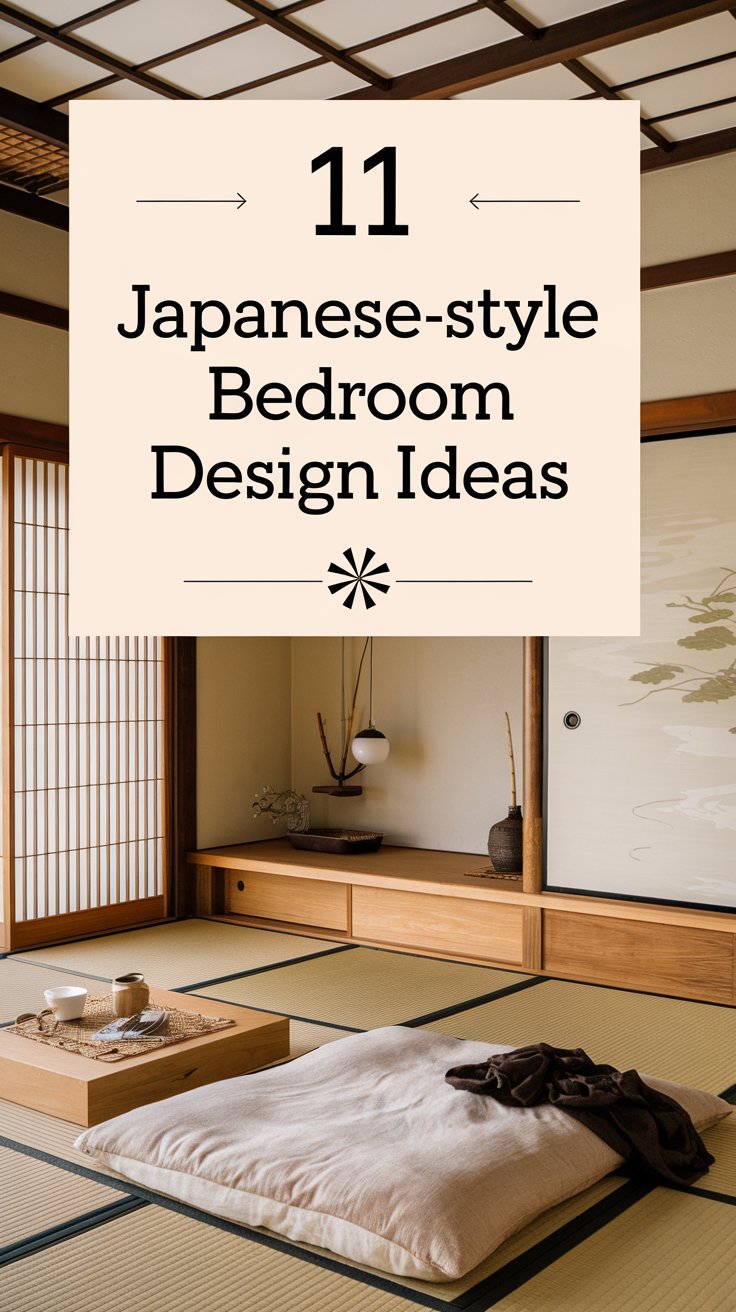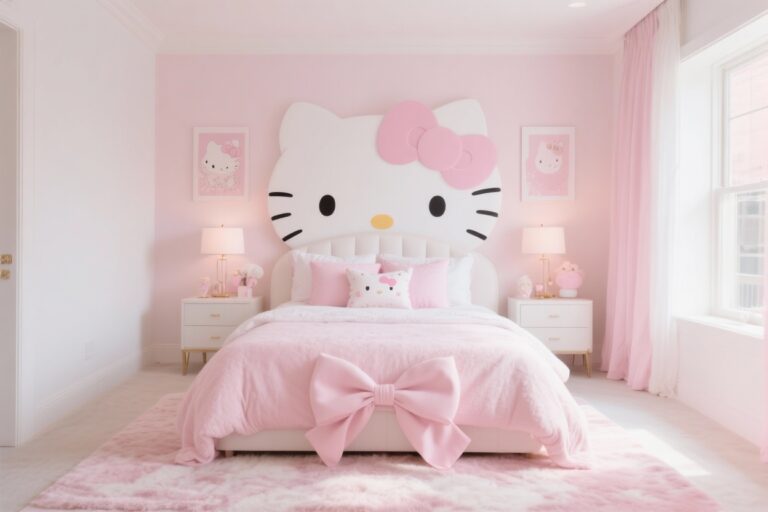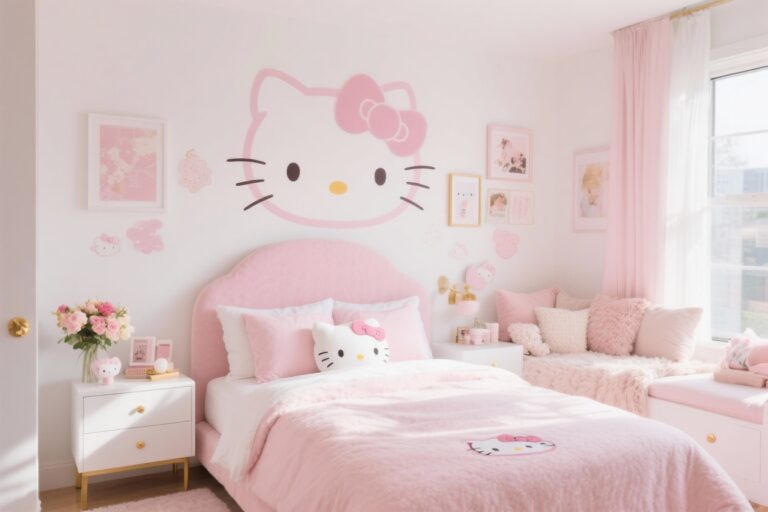The essence of Japanese interior design lies in simplicity, harmony, and a deep connection with nature. A Japanese-style bedroom is a perfect escape from the chaos of daily life, offering a calming retreat filled with natural materials, clean lines, and balanced aesthetics. Whether you want to create a full Zen sanctuary or just incorporate a few elements of Japanese design, these 11 ideas will help you achieve a peaceful and beautiful space.
1. Minimalist Futon Bed for an Authentic Look

In traditional Japanese homes, beds are not large, bulky pieces of furniture but simple futons placed directly on tatami mats. This approach keeps the bedroom airy, uncluttered, and true to Japanese minimalism. A futon can be folded and stored away, giving you extra space during the day.
Opt for a high-quality Japanese futon mattress that provides firm support and aligns with the simplicity of the room. If you prefer a raised sleeping surface, consider a low-profile platform bed made from natural wood. Pair it with neutral-toned bedding and soft textures for a warm and inviting feel.
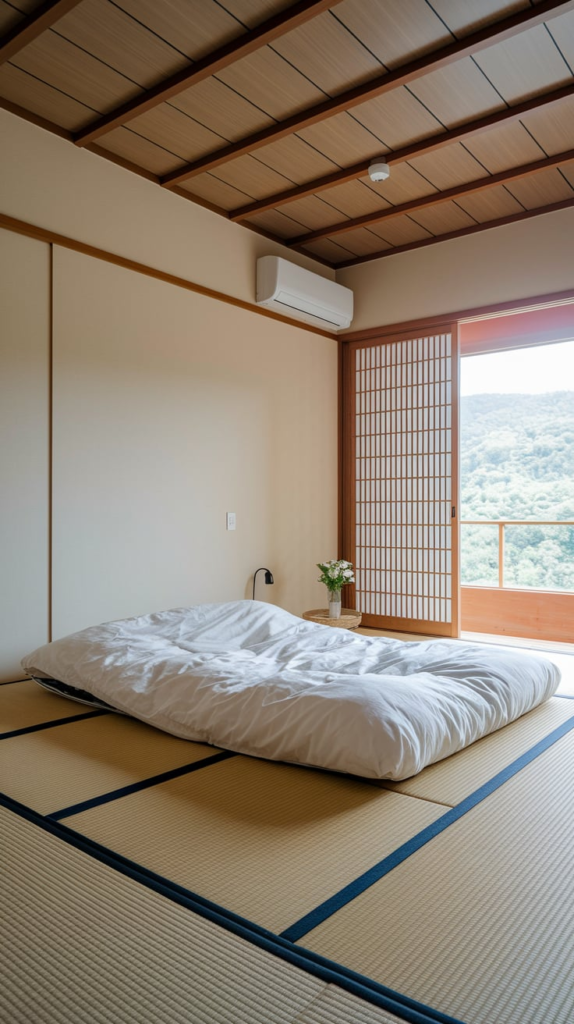
Keeping the bed low to the ground fosters a sense of grounding and connection with nature—one of the key principles of Japanese interior design.
Step by Step
- Choose a Futon: Get a traditional shikibuton (Japanese futon) or a modern futon-style mattress for comfort and authenticity.
- Use a Tatami Mat: Place a tatami mat underneath the futon for a natural, textured base.
- Opt for Low Furniture: If you prefer a raised bed, select a simple, low platform bed made of wood.
- Keep the Bedding Neutral: Use linen or cotton bedding in soft, natural colors like beige, white, or light gray.
- Store Away When Needed: If using a futon, fold and store it in a closet during the day for a spacious feel.
Imagine This: You step into your bedroom, and your futon is neatly placed on a soft tatami mat. The natural texture underfoot feels soothing, and the simplicity of the space allows your mind to relax. When morning comes, you fold your futon away, revealing an open, airy space ready for meditation or daily activities.
2. Natural Wood Elements for a Warm Ambiance

Japanese-style interiors often incorporate natural wood to create a sense of warmth and harmony. Whether it’s in the furniture, wall panels, or flooring, wood brings a timeless and organic feel to the bedroom.
Choose furniture made of light-colored wood like oak, cypress, or bamboo. If possible, expose wooden beams or add wood paneling to the walls. The key is to maintain clean, simple lines that highlight the natural beauty of the material.
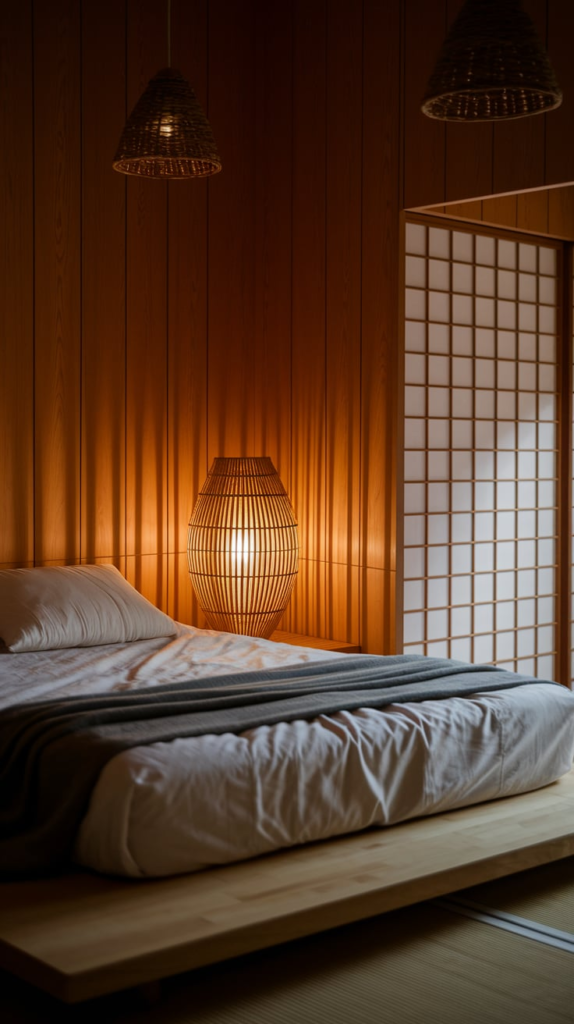
A bedroom that features wood elements feels cozy yet uncluttered, blending traditional aesthetics with modern comfort.
Step by Step
- Use Wooden Furniture: Choose nightstands, dressers, and shelving made from natural wood.
- Incorporate Wood Paneling: Add wooden wall panels or a headboard for a warm, Japanese-inspired touch.
- Opt for Bamboo Accents: Use bamboo lamps, blinds, or decor pieces for a subtle natural effect.
- Keep Finishes Light: Stick to light or medium wood tones for an airy and bright feel.
- Balance with Neutral Colors: Complement the wood with neutral-toned walls and soft textiles.
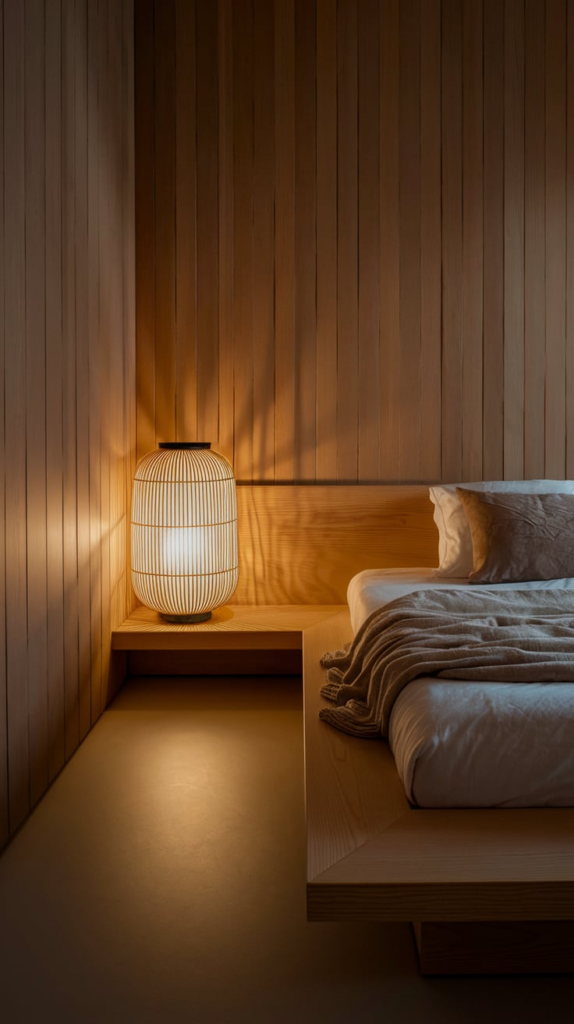
Imagine This: Your bedroom exudes warmth with wooden walls and a light oak platform bed. A bamboo lamp casts a soft glow in the evening, creating a cozy retreat. The natural materials make you feel grounded and relaxed, embracing the peaceful simplicity of Japanese design.
3. Shoji Screens for Soft, Diffused Light

Shoji screens are a hallmark of Japanese architecture, offering both functionality and aesthetic beauty. These translucent paper panels filter natural light, creating a soft and calming ambiance in the bedroom.
You can use Shoji screens as room dividers, closet doors, or window coverings. If traditional wooden screens are not an option, opt for modern alternatives made with frosted glass or light fabric panels. The goal is to achieve a similar diffused lighting effect that enhances the tranquil atmosphere.
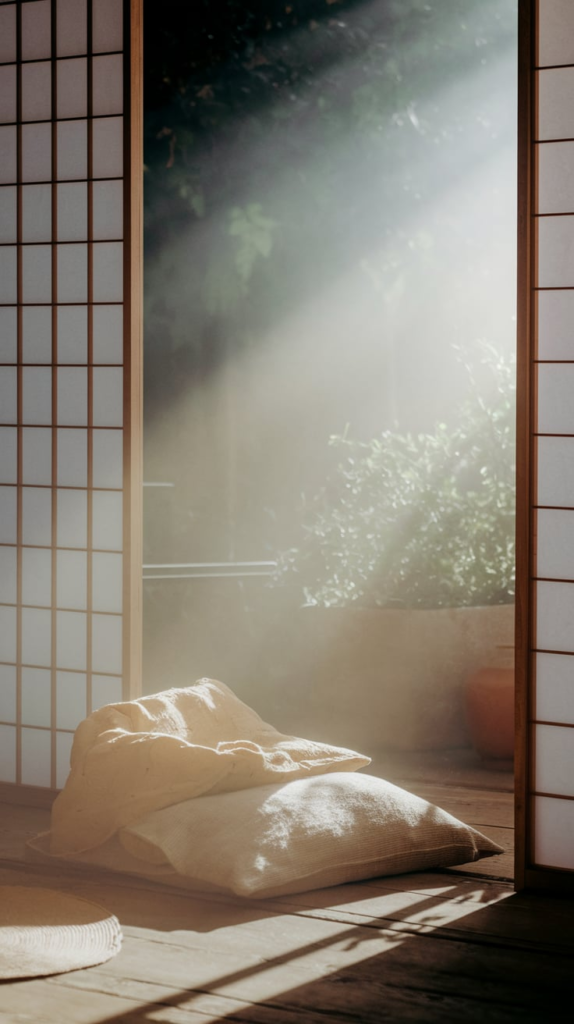
Shoji screens create a seamless blend between indoor and outdoor spaces, reinforcing the Japanese philosophy of nature integration.
Step by Step
- Use Shoji Screens as Room Dividers: Separate sleeping and dressing areas while maintaining an open feel.
- Install Shoji Sliding Doors: Replace standard closet or bedroom doors with Shoji-inspired sliding panels.
- Opt for Paper or Frosted Glass Screens: If traditional rice paper isn’t available, frosted glass panels offer a similar effect.
- Position Screens by Windows: Use Shoji screens as window coverings to create soft, diffused light.
- Maintain a Neutral Palette: Stick to white or cream-colored panels framed with light wood for a classic Japanese look.
Imagine This: Morning sunlight filters gently through your Shoji screen, filling the room with a soft glow. The diffused light creates a dreamy, peaceful atmosphere, perfect for slow mornings and mindful beginnings.
4. Zen-Inspired Decluttered Space
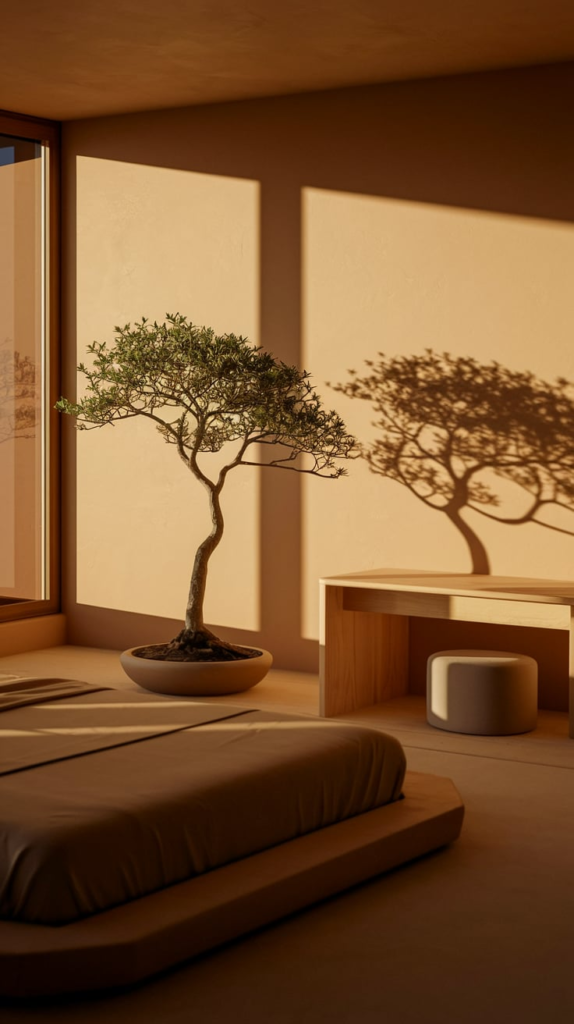
A true Japanese-style bedroom follows the principle of “Ma,” which means appreciating empty space. The idea is to create a decluttered, open environment that allows your mind to rest and breathe.
Keep furniture minimal—only include what is necessary, such as a bed, a small side table, and perhaps a single decorative element like a floor lamp or a bonsai plant. Storage should be hidden to maintain the serene aesthetic.

Adopting a minimalist approach doesn’t mean the space feels empty; instead, it exudes peace and mindfulness, making it a perfect retreat for relaxation.
Step by Step
- Remove Unnecessary Furniture: Keep only the essentials to maintain a clean, uncluttered space.
- Use Hidden Storage: Choose beds with built-in drawers or store items in closets to avoid visible clutter.
- Limit Decor: Opt for one or two carefully chosen decor pieces, like a small vase or a single framed artwork.
- Emphasize Open Space: Arrange furniture in a way that maximizes open space, allowing energy to flow freely.
- Follow a “Less is More” Approach: Each item should have a purpose and contribute to the tranquility of the space.
Imagine This: Your bedroom is a sanctuary of simplicity. A single bonsai tree sits by the window, and the soft light highlights the clean lines of your minimal furniture. The open space makes you feel at peace, allowing you to fully unwind and embrace a Zen mindset.
5. Tatami Mats for an Authentic Japanese Feel
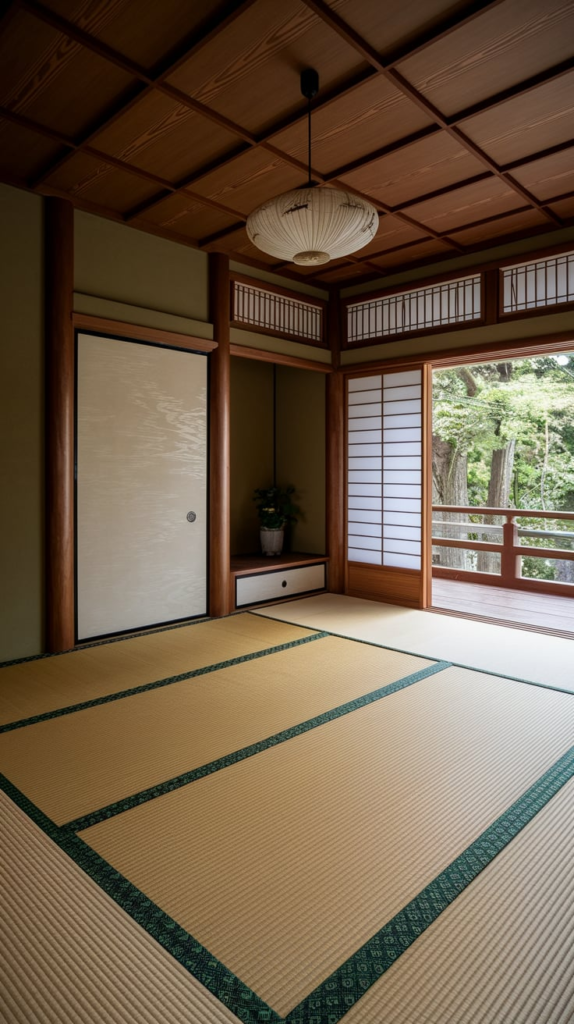
Tatami mats are a classic feature of Japanese interiors, traditionally used as flooring in bedrooms and living spaces. Made from woven rush grass and rice straw, these mats provide a soft yet firm surface that is both comfortable and breathable.
Using tatami mats instead of carpets or hardwood floors instantly enhances the authenticity of a Japanese-style bedroom. They also help regulate humidity and create a subtle, natural fragrance that adds to the calming atmosphere. You can cover the entire floor with tatami mats or place them beneath your futon or bed to introduce a touch of tradition.

Tatami mats embody the simplicity and harmony of Japanese interiors, creating a space that feels both grounding and serene.
Step by Step
- Measure Your Space: Determine whether you want to cover the entire floor or just a section with tatami mats.
- Choose the Right Size: Standard tatami mats are around 90 cm x 180 cm, but modular sizes are also available.
- Position Mats Strategically: Place them under a futon, next to the bed, or in a small meditation area.
- Maintain with Care: Keep tatami mats dry and clean to prevent mold and extend their lifespan.
- Pair with Minimal Decor: Keep the surrounding space simple to let the tatami mats shine as a natural feature.
Imagine This: You wake up and place your feet on the soft, woven surface of a tatami mat. The natural scent of rush grass fills the air, instantly grounding you in a sense of calm. The simplicity and warmth of the tatami set the perfect tone for a peaceful morning.
6. Soft, Neutral Color Palette for a Zen Atmosphere

Color plays a crucial role in creating a Japanese-style bedroom. The traditional Japanese aesthetic revolves around soft, neutral tones inspired by nature—think warm beiges, soft browns, muted greens, and earthy grays. These colors evoke a sense of tranquility and make the space feel open and breathable.
To achieve this look, choose bedding, walls, and furniture in neutral shades. Avoid bright or overly bold colors, as they can disrupt the peaceful ambiance. If you want a touch of color, use subtle accents in nature-inspired hues, such as deep green (bamboo) or soft blue (sky and water).
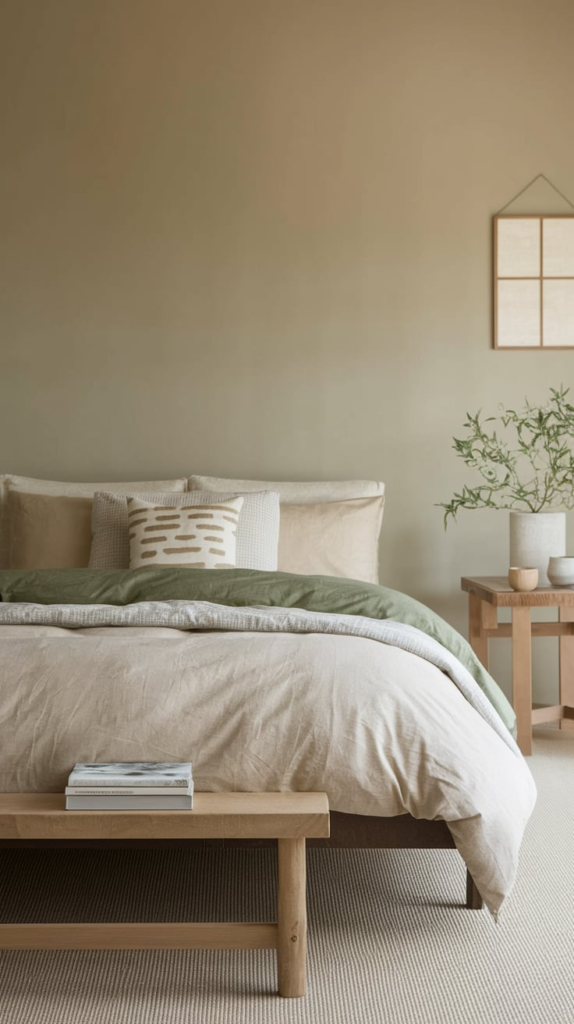
A soft, harmonious color palette creates a visually soothing environment that encourages relaxation and mindfulness.
Step by Step
- Select a Base Color: Choose a neutral tone like beige, white, or light gray for the walls and main furniture.
- Incorporate Natural Tones: Add warmth with wood, soft browns, or muted greens.
- Use Textiles to Soften the Look: Incorporate linen or cotton bedding in soft, earthy shades.
- Keep It Simple: Avoid excessive patterns or bold colors that disrupt the minimalist aesthetic.
- Add a Touch of Contrast: Use black or dark brown in small details (such as furniture legs or picture frames) for a subtle visual balance.

Imagine This: Your bedroom is bathed in soft, neutral tones. The walls are warm beige, the bedding is an earthy off-white, and wooden accents add a natural touch. The color palette makes the space feel light, airy, and effortlessly calming.
7. Japanese Paper Lanterns for Gentle Lighting
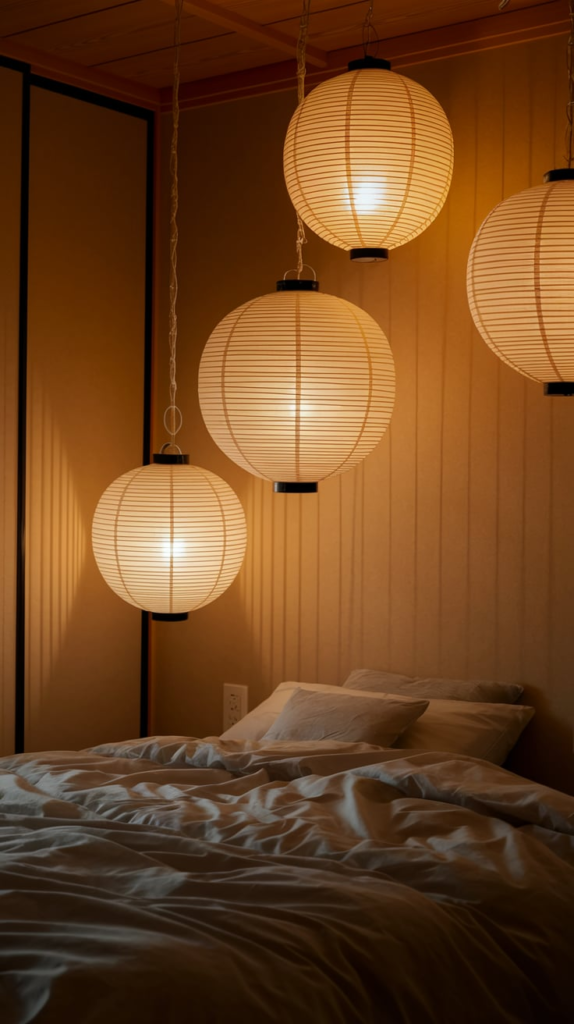
Lighting is essential in Japanese interior design, as it helps create a warm, inviting atmosphere. Instead of harsh overhead lights, Japanese bedrooms often use soft, diffused lighting from paper lanterns or shoji-style lamps.
Paper lanterns, known as Andon or Akari, emit a soft, warm glow that instantly makes the room feel peaceful. They are typically made from washi paper and bamboo or wood frames. You can hang a pendant-style lantern, place a floor lamp near your bed, or use small table lamps for subtle lighting.
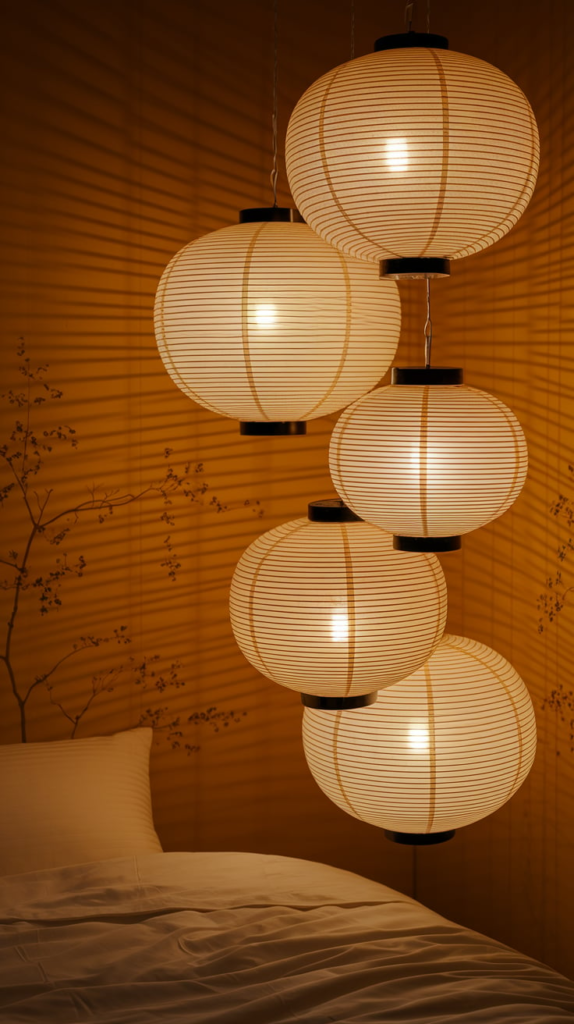
Choosing the right lighting will enhance the tranquility of your bedroom and contribute to the overall Zen-like experience.
Step by Step
- Choose Washi Paper Lanterns: Opt for handmade Japanese paper lanterns for an authentic touch.
- Place Lighting Strategically: Use soft bedside lamps or a hanging pendant light for gentle illumination.
- Opt for Warm, Low-Intensity Bulbs: Avoid bright white lights—warm LED bulbs create a cozier feel.
- Add Floor Lamps: A standing Shoji-style lamp can enhance the Japanese aesthetic.
- Layer the Lighting: Combine multiple light sources to create a balanced, diffused glow.
Imagine This: As evening falls, your paper lanterns emit a soft, golden glow. The light filters gently through the washi paper, casting delicate shadows on the walls. The ambiance is warm and peaceful, perfect for unwinding before sleep.
8. Sliding Doors or Curtains for Privacy and Elegance
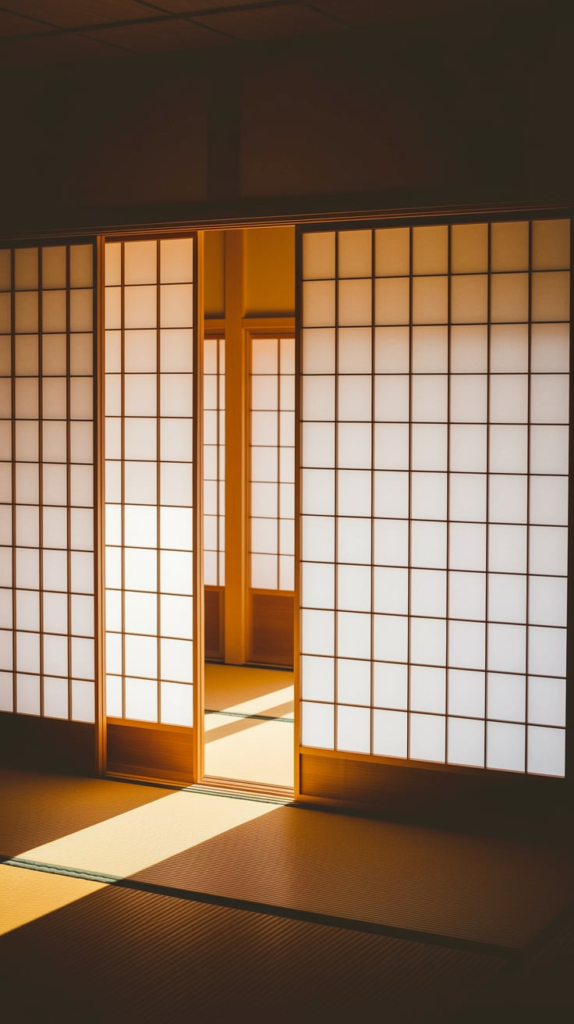
Instead of traditional hinged doors, Japanese bedrooms often feature sliding doors (fusuma or shoji). These doors help maintain an open, fluid space while still providing privacy when needed. If you can’t install sliding doors, lightweight linen or cotton curtains can achieve a similar effect.
Shoji screens with wooden frames and translucent paper panels allow light to pass through while keeping the space feeling airy. Fusuma doors, which are solid and covered with textured paper or fabric, can be used for closets or partitions.
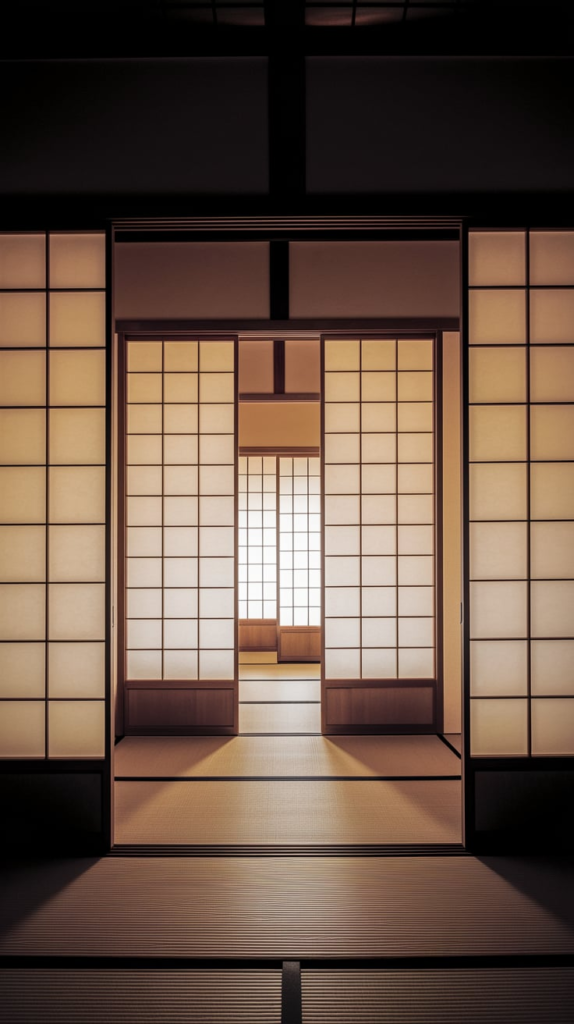
Replacing heavy doors with sliding alternatives enhances the minimal, seamless flow of your space.
Step by Step
- Install Shoji or Fusuma Doors: Use traditional sliding panels for closets or room dividers.
- Use Linen or Cotton Curtains: If sliding doors aren’t an option, lightweight fabric curtains work well.
- Keep Colors Neutral: Choose natural hues like white, beige, or soft gray to maintain harmony.
- Ensure Smooth Sliding Mechanisms: Proper installation ensures doors move effortlessly.
- Use for Closet Spaces: Replace closet doors with sliding panels to maintain the minimalist aesthetic.
Imagine This: You slide open a Shoji screen, revealing your softly lit bedroom. The seamless movement and gentle lighting create an effortless elegance, blending privacy with openness.
9. A Zen-Inspired Meditation Corner

A Japanese-style bedroom isn’t just for sleeping—it can also be a place for mindfulness and relaxation. Creating a small meditation or tea corner can add to the serene ambiance.
All you need is a simple floor cushion (zabuton), a small wooden table, and perhaps a calming element like a bonsai plant or a small water fountain. This dedicated space invites daily moments of quiet reflection.
Step by Step
- Choose a Quiet Corner: Select a peaceful spot in your bedroom.
- Add Floor Seating: Use a zabuton or low wooden bench.
- Keep It Simple: Avoid clutter—one or two meaningful decor pieces are enough.
- Incorporate Natural Elements: A small plant, stones, or a water feature enhance the space.
- Use This Space Daily: Even a few minutes of meditation or tea drinking can bring a sense of peace.
Imagine This: You sit on a soft zabuton, sipping tea in silence. The air is filled with the gentle scent of tatami, and the minimalist surroundings help you feel completely present and at peace.
10. Indoor Plants and Bonsai for a Touch of Nature

A Japanese-style bedroom is deeply connected to nature, and one of the best ways to bring that essence inside is through greenery. Japanese interiors often feature plants like bonsai trees, bamboo, or small potted plants that enhance the peaceful atmosphere.
Bonsai trees are a traditional and artistic way to incorporate nature into your bedroom. They require patience and care, symbolizing mindfulness and harmony. If maintaining a bonsai feels overwhelming, simple plants like lucky bamboo, snake plants, or peace lilies can also add a fresh, organic feel to the space.
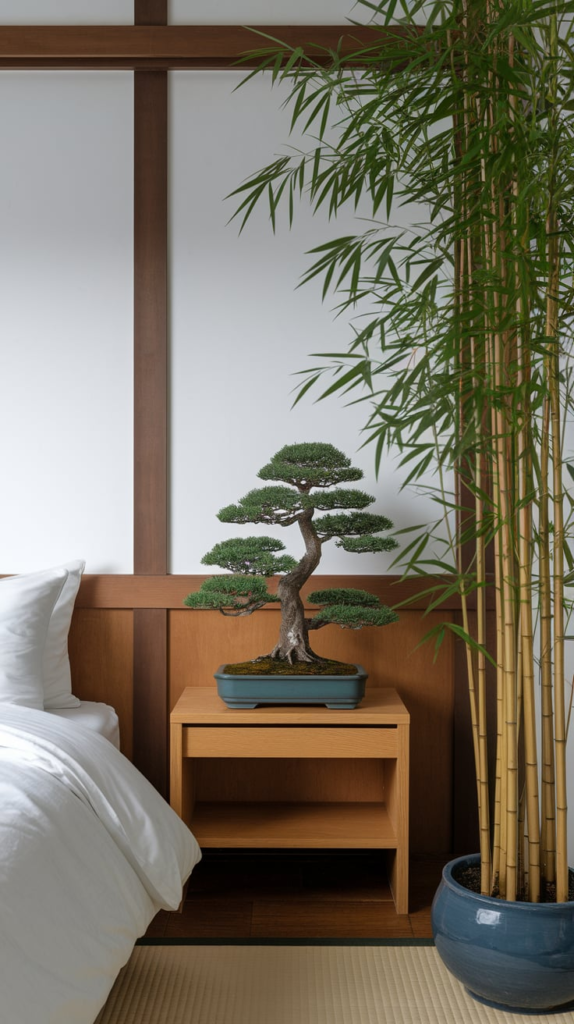
The key is to choose plants that align with the minimalist aesthetic—avoid cluttering the space with too many pots, and instead opt for a few carefully placed plants that contribute to the room’s overall balance.
Step by Step
- Choose the Right Plant: Bonsai trees, bamboo, peace lilies, or ferns work well in Japanese-style bedrooms.
- Use Simple, Natural Pots: Opt for ceramic, stone, or wooden pots in neutral colors.
- Place Plants Strategically: Keep one or two near windows, on a low table, or in a dedicated corner.
- Ensure Proper Lighting: Most indoor plants need indirect sunlight—position them accordingly.
- Maintain Regular Care: Water, trim, and care for your plants to keep them healthy and vibrant.
Imagine This: A tiny bonsai tree sits on your bedside table, its delicate branches carefully shaped over time. In the corner, a tall bamboo plant sways slightly as a soft breeze flows through the room. The greenery adds life and balance, making your space feel like a peaceful retreat.
11. Wabi-Sabi Decor for a Sense of Imperfection and Harmony
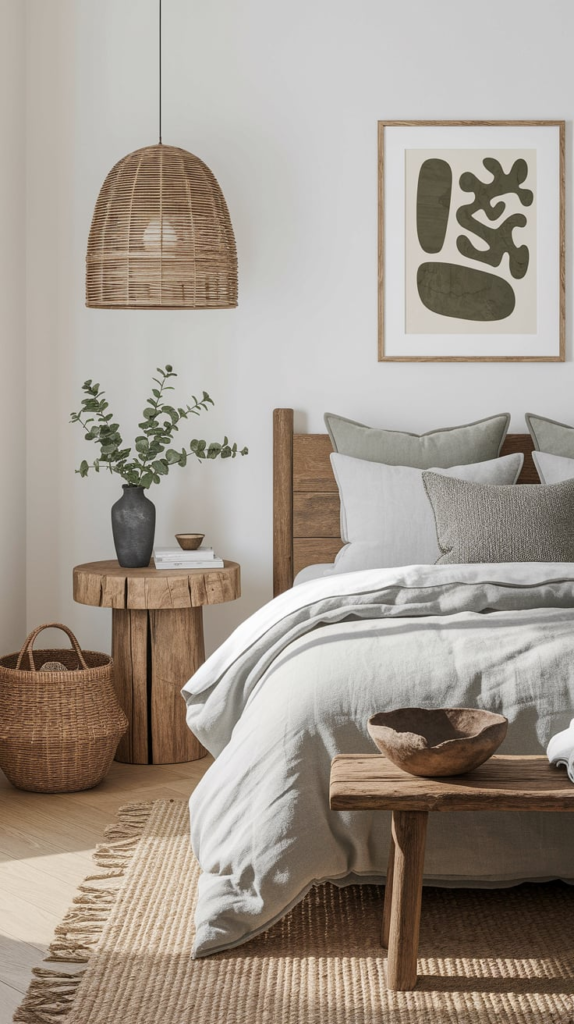
Wabi-sabi is a core Japanese design philosophy that embraces imperfection, simplicity, and the beauty of natural aging. Instead of striving for a flawless, polished look, wabi-sabi encourages the appreciation of worn textures, handmade ceramics, and naturally weathered materials.
Incorporating wabi-sabi into your bedroom can be as simple as using a rustic wooden side table, linen bedding with natural creases, or handcrafted pottery with uneven edges. The goal is to create an environment that feels authentic, lived-in, and harmonious rather than overly perfect.
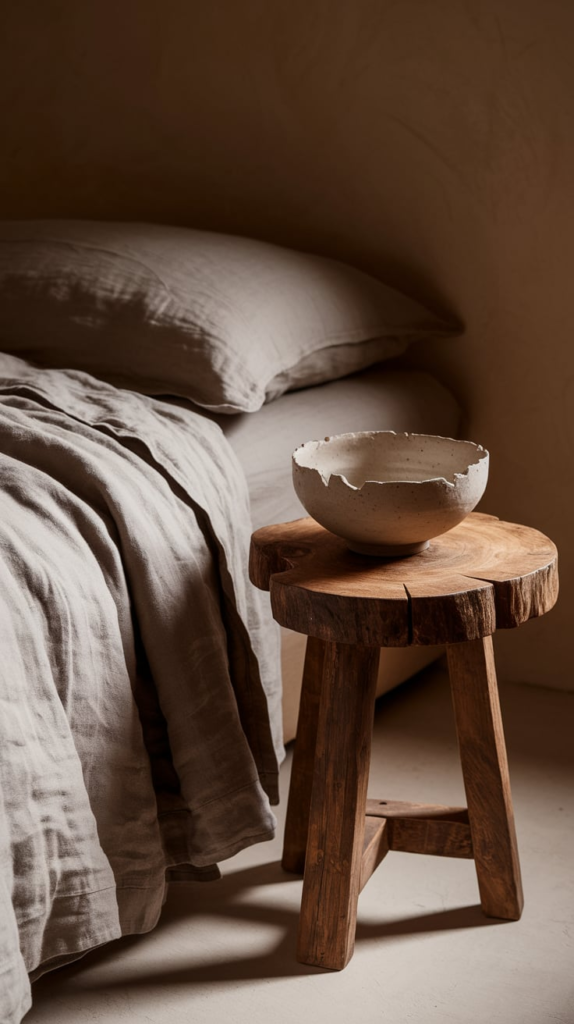
This philosophy aligns beautifully with a minimalist approach, helping you cultivate a space that feels warm, inviting, and deeply personal.
Step by Step
- Choose Natural, Aged Materials: Opt for linen, stone, wood, and ceramic with organic textures.
- Embrace Handmade Items: Use pottery, woven baskets, or handmade furniture for authenticity.
- Allow Imperfection: Cracks, uneven edges, and natural patinas add character to the space.
- Keep Decor Subtle: A single rustic vase, a weathered wooden tray, or a textured throw can enhance the wabi-sabi aesthetic.
- Create a Cozy Atmosphere: Soft lighting, warm textures, and an uncluttered layout complete the look.
Imagine This: Your linen duvet has gentle creases, adding a relaxed charm to your bed. A handmade ceramic bowl sits on your bedside table, its slightly uneven edges telling a quiet story of craftsmanship. The room feels authentic, peaceful, and beautifully imperfect—just as it should be.
And that’s it! With these 11 Japanese-style bedroom ideas, you can transform your space into a serene retreat inspired by Zen philosophy and nature. Which idea do you like the most? 😊
